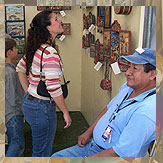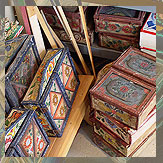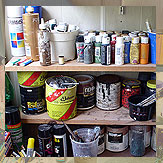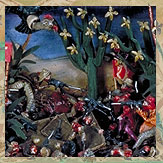<< Return Home
<< Regrese a la página principal
 |
 |
>>Watch video of Jiménez discussing a future project<<
The distinction between art and craft is important in western art, though many challenge this division. In Peru, the art forms developed before the Spanish invasion (weaving, ceramics, metallurgy, and others), which have evolved into modern forms, are generally referred to today as “popular arts,” and are considered crafts, not art. Thus the 1975 decision by Peru’s National Institute of Culture to award Peru’s National Art Prize to the retablo artist Joaquín López Antay was extremely controversial. Nicario strongly believes that he and his fellow retablo-makers are artists, not craftsworkers. He has constantly struggled to achieve recognition of retablos as art. In part, he has done this by trying to enter his retablos in juried art competitions, and through his ownership and management of art galleries in Lima, Peru, and Santa Fe and Sedona, United States. Nicario does make a distinction between the smaller, genre-scene retablos he constantly makes, and the one large piece he makes annually. He devotes his considerable intellectual and artistic talents to these small retablos, but saves his greatest innovations for the very large pieces, which he does not sell.
>>Mire Video de Jiménez discutiendo un proyecto futuro<<
The distinction between art and craft is important in western art, though many challenge this division. In Peru, the art forms developed before the Spanish invasion (weaving, ceramics, metallurgy, and others), which have evolved into modern forms, are generally referred to today as “popular arts,” and are considered crafts, not art. Thus the 1975 decision by Peru’s National Institute of Culture to award Peru’s National Art Prize to the retablo artist Joaquín López Antay was extremely controversial. Nicario strongly believes that he and his fellow retablo-makers are artists, not craftsworkers. He has constantly struggled to achieve recognition of retablos as art. In part, he has done this by trying to enter his retablos in juried art competitions, and through his ownership and management of art galleries in Lima, Peru, and Santa Fe and Sedona, United States. Nicario does make a distinction between the smaller, genre-scene retablos he constantly makes, and the one large piece he makes annually. He devotes his considerable intellectual and artistic talents to these small retablos, but saves his greatest innovations for the very large pieces, which he does not sell.
 |
 |

